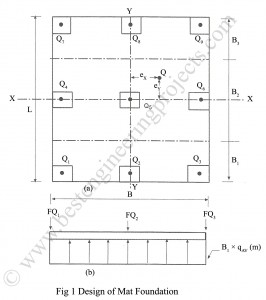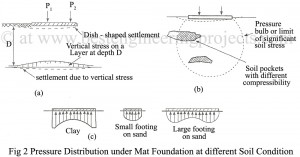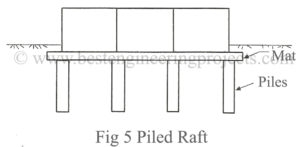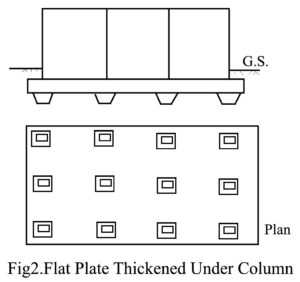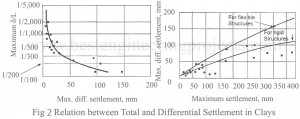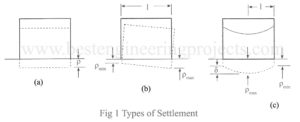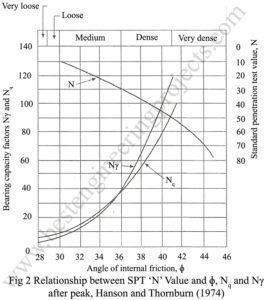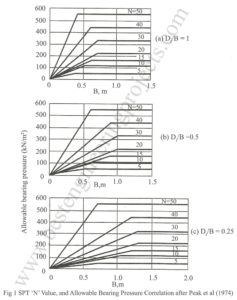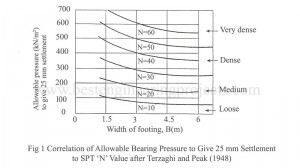Method of Analysis for Mat Foundation The objective of the analysis for mat foundation is to find the bearing pressure underneath the mat. This depends upon the rigidity of the mat, rigidity of the superstructure and rigidity of the supporting soil. These factors make the determination of bearing pressure much complicated and necessitate some simplifying assumptions to be made. After the determination of bearing pressure, shear and moment are computed. Conventional Method | Method of Analysis for Mat Foundation The basic assumptions in conventional method are: Foundation is rigid relative to…
Read MoreCategory: Civil Projects
Raft Foundation Design
Raft Foundation Design General Considerations A mat supported on strong bedrock transmits the load in a relatively small area near columns. The pressure distribution on raft foundation will be as shown Fig. 1(a). If the mat rests on stiff or compact soils, the mat distributes the load to the subsoil in larger areas as shown in Fig. 1(b). If the mat rests on weak soil the pressure distribution on the mat tends to be uniform as shown in Fig. 1(c). In raft foundation design, the stresses developed underneath the mat…
Read MoreSettlement of Raft Foundation
The settlement is not a problem for raft on sands as allowable bearing capacity is computed on the basis of settlement criteria. However, settlement is of great concern when a raft rests on a deposit of normally consolidated clay. The net foundation pressure for computing settlement is taken as: ———– (1) The pressure in the Eq. (1) shall not cause settlement in excess of permissible value. If settlement exceeds the permissible limits, the foundation pressure should be reduced either by increasing the area under the structures or by increasing…
Read MoreBearing Capacity of Mat Foundation
What is Bearing Capacity of Mat Foundation? Cohesionless Soil – In cohesionless soil a mat foundation does not fail in shear. For example, the bearing capacity of a raft foundation having a width of 6 m, and founded to a depth of 3 m in a sand deposit having relative density corresponding to SPT N-value of 10 is about 700 kN/m2 which is extremely high. In such case, the foundation may experience excessive settlement or even fail before attaining a bearing pressure of the order cited above. This means that the…
Read MoreMat Foundation | Types of Mat Foundation
A mat foundation is a thick reinforced concrete slab supporting arrangements of columns or walls in a row or rows and transmitting the loads to the soil. It is used to support storage tanks, industrial equipment, silos, chimneys, and various tower structures. A mat foundation is used when the subsoil is weak and column loads are so heavy that the conventional spread footings cover more than 50 % of the building area. It is common to use mat foundation or deep basements to transfer the column loads to the underlying…
Read MoreRelation between Total and Differential Settlement
Based on actual observations on buildings Bjerrurn (1963) has provided some relationships between total and differential settlement for sands and clay. These are shown in Figs.1 and 2 for sands and clays respectively. It is revealed from the graphs that, in granular soils, the minimum differential settlement can be equal to the maximum permissible settlement. While in clays the differential settlement is much less than the maximum permissible settlement. In sands, the maximum differential settlement seldom exceeds 3/4 of the total settlement, while in clays it seldom exceeds 1/2 of…
Read MoreSettlement of Foundation | Types of Settlement
Settlement is the vertical displacement from its original level of placement. Settlement has got several implications on a foundation. The implications include: Appearance of structures Utility of structures Damage to the structures Appearance of structures | Settlement of Foundation Settlement affects the appearance of structures. If a structure settles excessively, its aesthetic is impaired. It causes doors and windows to distort, walls and plasters to crack and the structure to tilt. Utility of Structures | Settlement of Foundation Settlement interfere the utility of structures in many ways. If settlement is excessive overhead…
Read MoreTeng’s method | Meyerhof’s method | Bowles method for net safe bearing pressure
Teng’s method – Teng (1962) based on the work of Terzaghi and Peck gave a relationship for allowable bearing capacity for a given permissible settlement. The equation is: qns = 35(N-3){(B+0.3)/2B}2RWRd ———- (1) Where, qns = Net safe bearing pressure, kN/m2 N = SPT value corrected for overburden pressure RW = Water table correction factor Rd = Depth correction factor = 1 + 0.2Df/B ≤1.2 The above equation can also written in general form as: qns = 1.4(N-3){(B+0.3)/2B}RwRdS ———- (2) Where, S = Permissible settlement in mm. Meyerhof’s…
Read MoreModification of Teraghi and Peak Correlation by Peak, Hanson and Thornburn
Peck, Hanson and Thornburn (1974) | Modification of Teraghi and Peak Correlation by Peak, Hanson and Thornburn Peck, Hanson and Thornburn (1974) have modified the original Terzaghi and Peck (1948) recommendations and presented charts as shown in Fig.1 to obtain allowable bearing pressure to give a settlement of 25 mm for a footing of known width, B with its base at a depth, Df resting on a granular deposit in which N (corrected SPT) values are measured. Procedure | Modification of Teraghi and Peak Correlation by Peak, Hanson and Thornburn N (corrected…
Read MoreCorrelation between Corrected SPT(N) and pressure by Teraghi and Peak
Terzaghi and Peck (1948) were the first to propose a correlation between the N (corrected SPT) Value and allowed pressure, by presenting a relationship between the size of a footing, the N (corrected SPT) value, and the applied pressure to give a settlement of 25 mm for a deep ground water table, This correlation is shown in Fig.1 below. Procedure: N should not be corrected with respect to overburden. N should be averaged from the given values. The graph has been developed with the condition that the water table is…
Read More